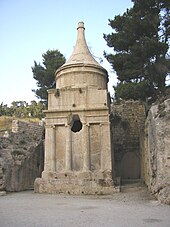Rock-cut architecture
This article cites its sources but does not provide page references. |
This article's tone or style may not reflect the encyclopedic tone used on Wikipedia. (January 2008) |

Rock-cut architecture is the practice of creating buildings by carving natural rock. In India the term 'cave' is often applied, and in China 'cavern,' but one must differentiate natural caves from rock-cut architecture which is man-made and designed along the conventions of architecture itself and thus in every respect a part of architecture and its history.[1] Though rock-cut architecture differs from traditional buildings in many obvious ways, many are often made to replicate traditional architectural forms in the facades and even in their interiors. The interiors were usually carved out by starting at what would wind up being the roof and then working downward, for the obvious reason that stones would not be falling on one's head. The three main uses of rock-cut architecture were temples (like those in India), tombs (like those in Petra, Jordan) and cave dwelling (like those in Cappadocia, Turkey).
Rock-cut architecture is also said to be cut, hewn, etc., "from the living rock".[2] Another term sometimes associated with rock-cut architecture is monolithic architecture, but it would apply only to completely free-standing structures.[dubious – discuss]
History

Rock-cut architecture occupies a particularly important place in the history of Indian Architecture, but the tradition goes back at least to the Great Temple of Ramesses II, known as Abu Simbel, located along the Nile in Nubia, near the borders of Sudan about 300 kilometers from Aswan in Egypt. It dates from about 1280 BCE, and consists of a monumentally scaled facade carved out of the cliff and a set of interior chambers that form its sanctuary.[3] In the 5th century BCE, the Lycians, who inhabited southern Anatolia (now Turkey) built hundreds of rock-cut tombs on a similar prototype, but smaller in scale.[citation needed] Excellent examples are to be found near Dalyan, a town in Muğla Province, along the sheer cliffs that faces a river. Since these served as tombs rather than as religious sites, the interiors were usually small and unassuming. The ancient Etruscans of central Italy also left an important legacy of rock-cut architecture, mostly tombs, as those near the city of Tarquinia.[citation needed]

The creation of rock-cut tombs in ancient Israel began in the 8th-century BCE and continued through the Byzantine period.

The Nabataeans in their city of Petra, now in Jordan, extended this tradition, carving their temples and tombs into the yellowish-orange rock that defines the canyons and gullies of the region. These structures, dating from 600 BCE to about 300 CE, are particularly important in the history of architecture given their experimental forms.[4] Here too, because the structrures served as tombs, the interiors were rather perfunctory. In Petra one even finds a theater where the seats are cut out of the rock.
The earliest instances of Indian rock-cut architecture ,The Barabar caves date from about the 3rd to the 2nd century BCE. They were built by the Buddhist monks and consisted mostly of multi-storey buildings carved into the mountain face to contain living and sleeping quarters, kitchens, and monastic spaces. [5] Some of these monastic caves had shrines in them of Buddha, bodhisattvas and saints.[6] As time progressed, the interiors became more elaborate and systemitized; surfaces were often decorated with paintings, such as those at Ajanta. At the beginning of the 7th century Hindu rock-cut temples began to be constructed at Ellora. Unlike most previous examples of rock-cut architecture which consisted of a facade plus an interior, these temples were complete three-dimensional buildings created by carving away the hillside. They required several generations of planning and coordination to complete. Other major examples of rock-cut architecture in India are at Ajanta and Pataleshwar.

The technological skills associated with making these complex structures moved into China along the trade routes. The Longmen Grottoes, the Mogao Caves and the Yungang Grottoes consist of hundreds of caves many with statues of Buddha in them. Most were built between 460–525 AD. There are extensive rock-cut buildings, including houses and churches in Cappadocia, Turkey.[7] They were built over a span of hundreds of years prior to the 5th century CE. Emphasis here was more on the interiors than the exteriors.

Another extensive site of rock-cut architecture is in Lalibela, a town in northern Ethiopia, where numerous churches, in three dimensions as at Ellora, were carved out of the rock. These structures, which date from the 12th and 13th centuries CE and which are the last significant examples of this architectural form, ranks as among the most magnificent examples of rock-cut architecture in the world, with both interior and exterior brought to fruition.[citation needed]
See also
- Monolithic church and monolithic architecture
- Dugout (shelter)
- Yaodong
- Cave monastery
- Lalibela
- Petra
- Thamud
- List of archaeological sites sorted by country
- List of colossal sculpture in situ
- List of megalithic sites
- Indian rock cut architecture
References
- ^ Francis Ching, Mark Jarzombek, Vikramaditya Prakash, A Global History of Architecture (Wiley, 2006)
- ^ Webster's Third New International Dictionary of the English Language, Unabridged, under "living".
- ^ Aidan Dodson. Egyptian Rock-Cut Tombs. Shire Publications 1999.
- ^ Rababeh, Shaher M. Rababeh, ’’How Petra was Built: an Analysis of the Construction Techniques of the Nabataean Freestanding Buildings and Rock-cut Monuments in Petra, Jordan (Oxford, England: Archaeopress), 2005.
- ^ S. Nagaraju Buddhist Architecture of Western India, c. 250 BC – AD 300 (Agam Kala Prakashan, 1981)
- ^ Vidya Dehejia, Early Buddhist Rock Temples; a Chronology. (Cornell University Press, 1972)
- ^ Spiro Kostof, Caves of God: the Monastic Environment of Byzantine Cappadocia (MIT Press, 1972). Vidya Dehejia, (Cornell University Press, 1972)
- Burgess, James and Fergusson J. Cave Temples of India. (London: W.H. Allen & Co., 1880. Delhi: Munshiram Manohar Lal Publishers Pvt Ltd., Delhi, 2005).
